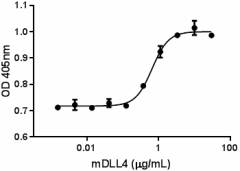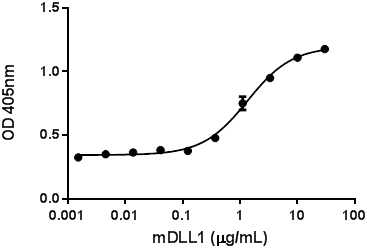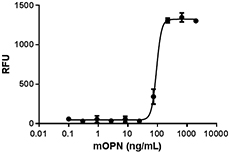- Regulatory Status
- RUO
- Other Names
- Delta-like protein 4, Dll4, DLL-4
- Ave. Rating
- Submit a Review
- Product Citations
- publications

-

Recombinant Mouse DLL4 enhances BMP9 induced alkaline phosphatase production in C3H10T1/2 cells with an ED50 of 0.2 - 0.8 µg/mL. -
Stability testing for Mouse DLL4. Mouse DLL4 was aliquoted in PBS, pH 7.2 at 0.2 mg/mL. One aliquot was frozen and thawed four times (4x freeze/thaws), and compared to a control kept at 4°C (control). The samples were tested for their ability to enhance BMP9 induced alkaline phosphatase production in C3H10T1/2 cells.
DLL4 (Delta-like protein 4) is a type I membrane protein that belongs to the DSL (Delta/Serrate/Lag2) family of Notch ligands and plays an important role in vascular development. There are five Notch ligands (DLL1, DLL3, DLL4, Jagged-1 and Jagged-2) and four Notch receptors (Notch-1 to Notch-4) in mammals. Interactions of Notch receptors with their ligands result in sequential proteolysis by ADAM (disintegrin metalloprotease) and then by presenilin/ gamma secretase, resulting in the shedding of the extracellular domains and the generation of soluble ICD (intracellular domain) signaling fragments. The Notch ICD translocates to the nucleus and interacts with transcriptional factors to promote the transcription of target genes. The ICDs of the Notch ligands have also been shown to translocate to the nucleus upon binding its receptor. DLL4 is induced by VEGF (vascular growth factor) and functions as a downstream modulator of VEGF mediated angiogenesis. DLL4/Notch signaling restrains the excessive branching and sprouting of endothelials in response to VEGF signaling. Deletion of a single copy of DLL4 results in severe vascular defects and embryonic lethality, indicating the essential role of DLL4/Notch signaling in vascular development. DLL4 is also up-regulated in tumour vasculature and the blockade of DLL4/Notch signaling inhibits tumour growth by increasing functionally defective vasculature.
Product DetailsProduct Details
- Source
- Mouse DLL4, amino acids Ser28-Pro525 (Accession # NM_019454.3) with a C-terminal 8His tag was expressed in 293E cells.
- Molecular Mass
- The 511 amino acid recombinant protein has a predicted molecular mass of approximately 55.7 kD. The DTT-reduced and non-reduced proteins migrate at approximately 68 kD by SDS-PAGE. The predicted N-terminal amino acid is Ser.
- Purity
- > 95%, as determined by Coomassie stained SDS-PAGE.
- Formulation
- 0.22 µm filtered protein solution is in PBS, pH7.2.
- Endotoxin Level
- Less than 0.1 EU per µg protein as determined by the LAL method.
- Concentration
- 10 and 25 µg sizes are bottled at 200 µg/mL. 100 µg size and larger sizes are lot-specific and bottled at the concentration indicated on the vial. To obtain lot-specific concentration and expiration, please enter the lot number in our Certificate of Analysis online tool.
- Storage & Handling
- Unopened vial can be stored between 2°C and 8°C for up to 2 weeks, at -20°C for up to six months, or at -70°C or colder until the expiration date. For maximum results, quick spin vial prior to opening. The protein can be aliquoted and stored at -20°C or colder. Stock solutions can also be prepared at 50 - 100 µg/mL in appropriate sterile buffer, carrier protein such as 0.2 - 1% BSA or HSA can be added when preparing the stock solution. Aliquots can be stored between 2°C and 8°C for up to one week and stored at -20°C or colder for up to 3 months. Avoid repeated freeze/thaw cycles.
- Application
-
Bioassay
- Application Notes
-
BioLegend carrier-free recombinant proteins provided in liquid format are shipped on blue ice. Our comparison testing data indicates that when handled and stored as recommended, the liquid format has equal or better stability and shelf-life compared to commercially available lyophilized proteins after reconstitution. Our liquid proteins are verified in-house to maintain activity after shipping on blue ice and are backed by our 100% satisfaction guarantee. If you have any concerns, contact us at tech@biolegend.com.
- Product Citations
-
Antigen Details
- Distribution
-
Endothelial cells
- Function
- Induced by VEGF
- Interaction
- Endothelial cells
- Ligand/Receptor
- Notch-1, Notch-4
- Bioactivity
- Enhance BMP9 induced alkaline phosphatase production in C3H10T1/2 cells.
- Cell Type
- Endothelial cells, Embryonic Stem Cells
- Biology Area
- Angiogenesis, Apoptosis/Tumor Suppressors/Cell Death, Cell Biology, Immunology, Stem Cells
- Molecular Family
- Adhesion Molecules
- Antigen References
-
- Shutter JR, et al. 2000. Genes Dev. 14:1313-8.
- Yoneya T, et al. 2001. J. Biochem. 129:27-34.
- Gale NW, et al. 2004. Proc. Nat. Acad. Sci. 101:15949-54.
- Hellstrom M, et al. 2007. Nature 445:776-80
- Lobov IB, et al. 2007. Proc. Nat. Acad. Sci. 104:3219-24.
- Noguera-Troise I, et al. 2006. Nature 444:1032-7.
- Ridgway J, et al. 2006. Nature 444:1083-7.
- Gene ID
- 54485 View all products for this Gene ID
- UniProt
- View information about DLL4 on UniProt.org
Related FAQs
- Why choose BioLegend recombinant proteins?
-
• Each lot of product is quality-tested for bioactivity as indicated on the data sheet.
• Greater than 95% Purity or higher, tested on every lot of product.
• 100% Satisfaction Guarantee for quality performance, stability, and consistency.
• Ready-to-use liquid format saves time and reduces challenges associated with reconstitution.
• Bulk and customization available. Contact us.
• Learn more about our Recombinant Proteins. - How does the activity of your recombinant proteins compare to competitors?
-
We quality control each and every lot of recombinant protein. Not only do we check its bioactivity, but we also compare it against other commercially available recombinant proteins. We make sure each recombinant protein’s activity is at least as good as or better than the competition’s. In order to provide you with the best possible product, we ensure that our testing process is rigorous and thorough. If you’re curious and eager to make the switch to BioLegend recombinants, contact your sales representative today!
- What is the specific activity or ED50 of my recombinant protein?
-
The specific activity range of the protein is indicated on the product datasheets. Because the exact activity values on a per unit basis can largely fluctuate depending on a number of factors, including the nature of the assay, cell density, age of cells/passage number, culture media used, and end user technique, the specific activity is best defined as a range and we guarantee the specific activity of all our lots will be within the range indicated on the datasheet. Please note this only applies to recombinants labeled for use in bioassays. ELISA standard recombinant proteins are not recommended for bioassay usage as they are not tested for these applications.
- Have your recombinants been tested for stability?
-
Our testing shows that the recombinant proteins are able to withstand room temperature for a week without losing activity. In addition the recombinant proteins were also found to withstand four cycles of freeze and thaw without losing activity.
- Does specific activity of a recombinant protein vary between lots?
-
Specific activity will vary for each lot and for the type of experiment that is done to validate it, but all passed lots will have activity within the established ED50 range for the product and we guarantee that our products will have lot-to-lot consistency. Please conduct an experiment-specific validation to find the optimal ED50 for your system.
- How do you convert activity as an ED50 in ng/ml to a specific activity in Units/mg?
-
Use formula Specific activity (Units/mg) = 10^6/ ED50 (ng/mL)
 Login / Register
Login / Register 













Follow Us